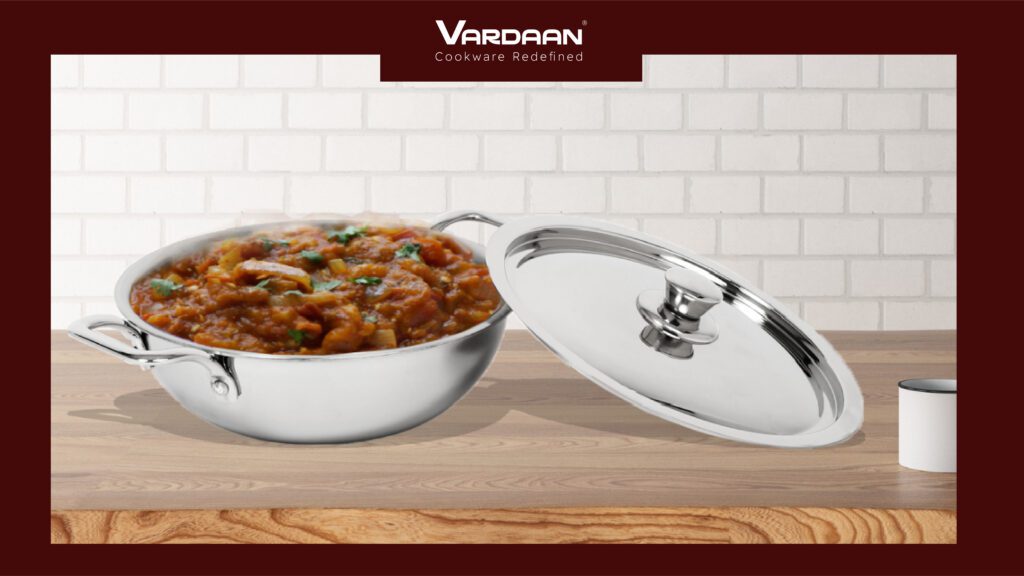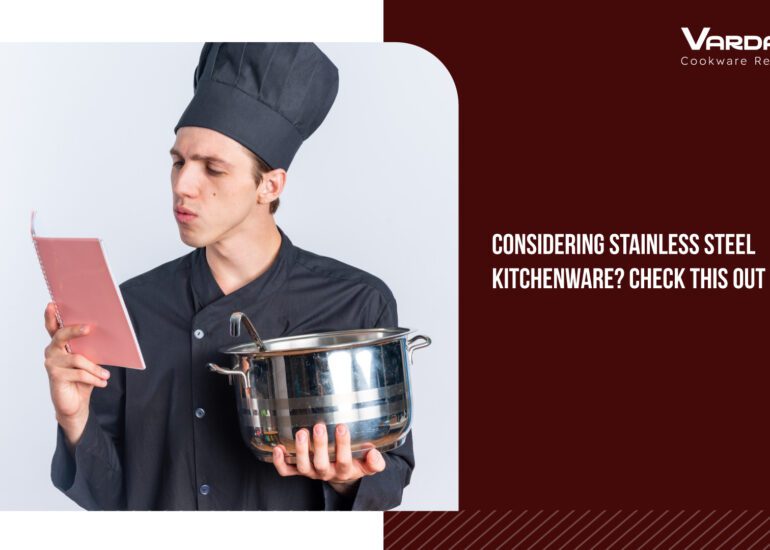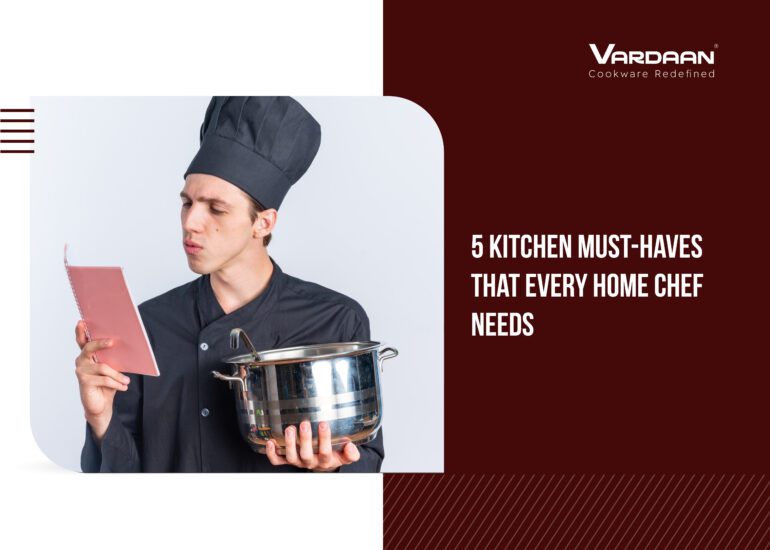Indian cuisine is a mesmerizing tapestry of flavors, spices, and cooking techniques that have evolved over millennia. It’s a gastronomic journey through a diverse landscape that stretches from the Himalayan peaks to the southern coastal shores. Each region boasts its culinary traditions, with a kaleidoscope of flavors. The use of aromatic spices like cumin, coriander, turmeric, and cardamom defines Indian cooking. From fragrant biryanis to fiery curries, and crispy dosas to rich Mughlai kebabs, Indian cuisine offers a treasure trove of tastes and textures. It’s a culinary adventure that explores sweet, savory, spicy, and sour, creating a sensory feast that’s unlike any other cuisine on the planet.
The Kadhai, a versatile and indispensable piece of cookware in Indian kitchens, is celebrated for its ability to craft a wide range of dishes. From quick stir-fries to elaborate curries, from deep-frying delectable snacks to slow-cooking succulent meat, the stainless steel Kadhai is the unsung hero of Indian cooking. Its unique shape and design facilitate efficient heat distribution, ensuring that dishes are cooked to perfection. Vardaan Cookware’s Cookware Buying Guide Vardaan Cookware can help you choose the perfect stainless steel Kadhai to elevate your Indian culinary adventures, enhancing your ability to prepare authentic, flavorful dishes.
Types of Kadhai Materials
Stainless Steel Kadhai
- Durability: Resistant to dents and dings, ensuring a long lifespan.
- Even Heating: Provides uniform heat distribution, preventing hotspots and promoting consistent cooking.
- Resistance to Corrosion: Highly resistant to rust and corrosion, maintaining its quality over time.
Cast Iron Kadhai
- Heat Retention: Exceptional heat retention, ensuring consistent cooking temperatures.
- Natural Non-Stick: Develop a natural non-stick seasoning with use.
- Durability: With proper maintenance, it can last for generations.
Aluminium Kadhai
- Quick Heating: Lightweight and heats up rapidly for efficient cooking.
- Affordability: An economical option for cooking needs.
- Non-Stick Coating: Often requires a non-stick coating for easy cleaning.
Copper Kadhai
- Heat Conductivity: Excellent heat conductivity for precise cooking control.
- Aesthetic Appeal: Offers a visually appealing cookware option.
- Lined with Stainless Steel: Typically lined with stainless steel due to copper’s reactivity with certain foods.
Stainless steel Kadhai shines in terms of durability, even heating, and corrosion resistance, making it a preferred choice for versatile and long-lasting cookware. For an in-depth guide, refer to Vardaan Cookware’s Cookware Buying Guide.
Choosing the Right Size and Depth
Selecting the right size and depth of a stainless steel Kadhai is crucial for effective cooking. Consider the number of servings and the types of dishes you intend to prepare. For small families or individual servings, a Kadhai with a capacity of 2-3 liters is adequate. If you’re cooking for a larger group, opt for a 4-5 liter Kadhai. The depth matters too; shallower Kadhai are excellent for stir-fries and quick cooking, while deeper ones are suitable for curries and deep-frying. Vardaan Cookware’s Cookware Buying Guide provides a comprehensive overview to assist in making the perfect selection for your culinary needs.
Handles and Weight Considerations
Ergonomic handles and a manageable weight are vital factors when choosing a stainless steel Kadhai, especially for those crafting Indian recipes that demand frequent stirring and tossing. The ergonomic design ensures a comfortable grip and minimizes strain on your hands, even during extended cooking sessions. A manageable weight, not too heavy, allows for easy maneuvering and tossing of ingredients, a common practice in Indian cooking. These features enhance user-friendliness and make the cooking process more enjoyable and efficient. Refer to Vardaan Cookware’s Cookware Buying Guide for a detailed understanding of these essential considerations in selecting the perfect Kadhai.
Understanding Bottom Thickness
The thickness of a Kadhai’s bottom is of paramount importance in Indian cooking. It directly impacts heat distribution and the prevention of burning or uneven cooking. A thicker bottom ensures even heat distribution, which is essential for Indian recipes that require slow cooking, simmering, or sautéing. It prevents hotspots and minimizes the risk of food sticking to the Kadhai’s surface, reducing the likelihood of burning. This even heat distribution allows for precise control over the cooking process, resulting in dishes that are perfectly cooked, with flavors harmoniously blended. Whether you’re making a rich curry or frying crispy pakoras, the bottom thickness plays a crucial role in achieving culinary excellence.
Seasoning and Maintaining Stainless Steel Kadhai

Seasoning a Stainless Steel Kadhai:
- Wash and Dry: Start by washing the Kadhai with warm, soapy water to remove any manufacturing residues. Rinse it thoroughly and allow it to dry completely.
- Apply Oil: Once the Kadhai is dry, apply a thin layer of any cooking oil with a high smoke point (like vegetable oil) to the interior. You can use a paper towel or cloth to spread the oil evenly.
- Heat Gradually: Place the oiled Kadhai on a stovetop and heat it gradually over low to medium heat. Allow the oil to heat until it begins to smoke.
- Cool and Wipe: Turn off the heat and let the Kadhai cool down. Once it’s safe to touch, wipe away the excess oil with a clean paper towel.
- Ready for Use: Your Kadhai is now seasoned and ready for use. Over time, with each use, the seasoning will improve.
Cleaning and Maintenance:
- After each use, wash the Kadhai with warm soapy water and a soft sponge. Avoid abrasive scrubbers or harsh detergents that can damage the seasoning.
- Dry the Kadhai thoroughly after washing to prevent water spots and the development of rust.
- If the seasoning becomes damaged or food starts sticking, repeat the seasoning process.
- Store the Kadhai in a dry place to prevent moisture or humidity from affecting the seasoning.
- Avoid using high heat settings regularly, as this can affect the seasoning. Cooking on medium heat is often sufficient.
By following these steps for seasoning and adopting good cleaning and maintenance practices, you’ll keep your stainless steel Kadhai in excellent condition, ensuring its shine and functionality for many years to come.
Best Indian Dishes to Cook in a Kadhai
A Kadhai’s versatility in Indian cooking knows no bounds. Here’s a list of popular Indian recipes that are best prepared in a Kadhai, highlighting its adaptability:
- Curries: Whether it’s a rich and creamy paneer curry or a spicy chicken masala, the Kadhai is perfect for simmering and slow-cooking curries to perfection.
- Stir-Fries: Kadhai is the ideal vessel for quick stir-frying vegetables, tofu, or meat with aromatic spices for dishes like bhindi masala or pepper chicken.
- Deep-Fried Snacks: Make crispy pakoras, samosas, and other deep-fried snacks in the Kadhai, as it retains high heat and ensures an even frying process.
- Sabzis (Dry Vegetables): Prepare dry vegetable dishes like aloo gobi, bhindi ki sabzi, or baingan bharta in the Kadhai, enhancing their flavors.
- Fried Rice: Whip up delicious vegetable or chicken fried rice with the Kadhai’s wide surface area, allowing for uniform mixing and frying.
- Sweets and Desserts: From making a decadent gajar ka halwa to frying jalebis, the Kadhai is essential for many Indian sweets.
- Bread: Use it for preparing Indian bread like parathas or puris, which require deep-frying and puffy expansion.
The Kadhai’s adaptability and ability to handle a variety of cooking styles make it a cornerstone of Indian kitchens.
Expert Tips and Techniques
| CHEF TIPS FOR MASTERING INDIAN COOKING WITH A STAINLESS STEEL KADHAI | TECHNIQUE |
| Maintain the Heat | – Heat the Kadhai gradually on medium heat before adding oil or ingredients to ensure even cooking. |
| Use Quality Spices | – Invest in high-quality spices and toast them in the Kadhai for enhanced flavor. |
| Tempering (Tadka) | – Master the art of tempering by adding spices to hot oil and infusing them into the dish. |
| Balancing Flavors | – Achieve the perfect balance of sweet, sour, spicy, and savory flavors by adjusting ingredients during cooking. |
| Layering Flavors | – Layer the ingredients and spices in the Kadhai to create depth and complexity in the dish. |
| Stirring Techniques | – Stirring is key; use a combination of gentle tossing, flipping, and stirring for different recipes. |
| Timing is Crucial | – Timing is everything; know when to add specific ingredients for the best results. |
| Prevent Overcrowding | Avoid overcrowding the Kadhai as it can lead to uneven cooking; cook in batches if needed. |
| Patience Pays Off | Some dishes benefit from slow cooking, so be patient and let the flavors meld. |
| Seasoning Knowledge | – Understand how to season your Kadhai and how it affects the dish’s final taste. |
These tips from experienced chefs can elevate your Indian cooking skills using a stainless steel Kadhai, ensuring your dishes are bursting with authentic flavors and textures.
Conclusion: Elevating Your Culinary Journey
Choosing the right stainless steel Kadhai is paramount for mastering the art of Indian cuisine. Its versatility, even heating, and durability are indispensable in creating the rich, authentic flavors and textures that define Indian dishes. From slow-cooked curries to crispy pakoras, the Kadhai’s wide range of applications makes it an essential tool in your kitchen.
Investing in a high-quality stainless steel Kadhai is an investment in your culinary journey. It ensures you can achieve the perfect balance of spices, and layer flavors, and employ traditional Indian cooking techniques with ease. Vardaan Cookware’s Cookware Buying Guide provides a comprehensive resource to help you make an informed choice. To embark on a delightful culinary experience and savor the true essence of Indian cooking, consider the right stainless steel Kadhai as your trusted companion. Visit Vardaan Cookware to explore their range of Kadhai options and take the first step towards culinary excellence. Your tastebuds will thank you.




